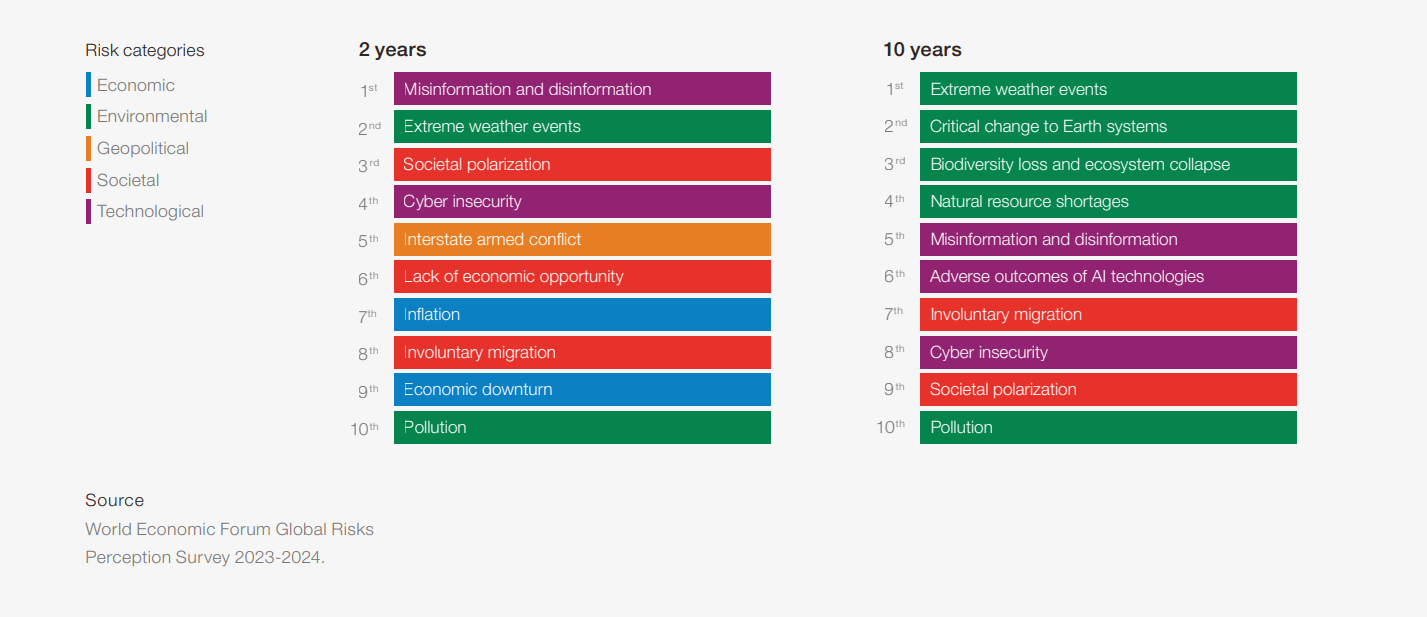Environmental risks continue to dominate the global risks landscape across all three-time frames- one, two, and ten years. Extreme weather, intensified by the warming phase of the El Niño-Southern Oscillation (ENSO) cycle, is ranked as the top risk most likely to present a material crisis on a global scale in 2024. This risk is also seen as the second-most severe over the two-year time frame. Alarmingly, nearly all environmental risks feature among the top 10 over the longer term.

However, a disparity in perceptions of urgency among key decision-makers implies sub-optimal alignment and decision-making. While the private sector highlights biodiversity loss, ecosystem collapse, and critical change to Earth systems as top concerns over the long term, respondents from civil society and government prioritize these risks over shorter time frames. This discrepancy heightens the risk of missing key moments of intervention, potentially resulting in long-term changes to planetary systems, a dangerous prospect highlighted in the report.
A planetary tipping point?
The notion of passing a “climate tipping point” within the next decade adds a layer of urgency. Researchers suggest that crossing this threshold, likely to occur by the early 2030s with 1.5°C of global warming, could trigger irreversible changes to planetary systems. The report delves into the potential consequences of crossing this critical threshold, pointing to the unpreparedness of many economies for the non-linear impacts that might follow.
Experts foresee a highly related cluster of environmental risks, with direct links to critical changes in earth systems. This includes biodiversity loss, ecosystem collapse, extreme weather events, and pollution, all of which have a strong potential to lead to natural resource shortages. These events not only have environmental implications but also possible socioeconomic implications, including involuntary migration, chronic health conditions, infectious diseases and economic downturn. This nexus of socioenvironmental risks has the potential to accelerate climate change and amplify related impacts, threatening climate-vulnerable populations.
The collective ability of societies to adapt could be overwhelmed. The report highlights that developing countries are particularly vulnerable, as their adaptation efforts could be constrained by finances, alongside the sheer scale of infrastructure investment requirements over the next decade. Advanced economies will also be impacted, as illustrated by countries like Australia where it’s projected that close to 521,000 homes could become uninsurable by 2030 due to the increased risks associated with extreme weather. This could leave some countries and communities, both developing and advanced, unable to absorb both the acute and chronic effects of climate change.
How businesses can respond
Businesses can play a crucial role in mitigating these risks. By staying informed about the findings outlined in the report, businesses can make better decisions and develop effective risk management strategies. The urgency of these environmental issues suggests that the private sector should start prioritizing them as immediate threats rather than relegating them to long term concerns.
Businesses must not only assess their immediate exposure to environmental risks but also consider the potential ripple effects on socioeconomic factors. To achieve this, they can begin by reviewing the influence they have on their external environment, whether that is within their industry or the communities in which they serve, and seek to form collaborative partnerships with other stakeholders to address some of these systemic and societal issues. This collaborative approach not only helps mitigate risks but also fosters a sense of shared responsibility and community. Furthermore, businesses should assess how their business models and operations positively contribute to addressing these risks. By incorporating these insights, companies can better equip themselves to handle these challenges and contribute to global resilience in the face of environmental issues.

